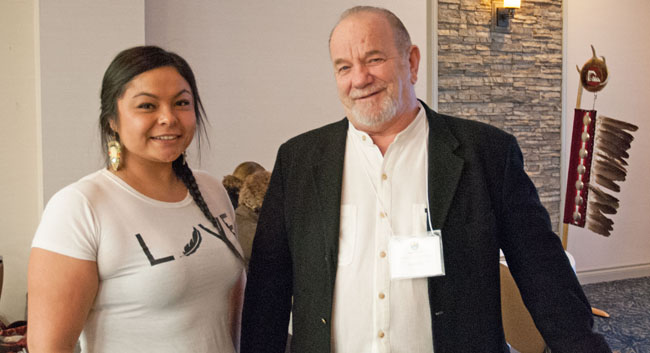Working together, sharing together

By KA Smith
NORTH BAY –Focusing on urban strategic planning, the North Bay Indian Friendship Centre has successfully hosted the Working Together, Sharing Together Conference. Designed to keep the momentum rolling working on North Bay’s Urban Aboriginal Strategy, the two-day conference on March 31 and April 1st drew in managers, social workers, elders, policing services, entrepreneurs, politicians, academics and artists. Anyone asked claimed to benefit from the conference experience.
“Better communication is so important moving forward”, replied Geneviève Couchie. She is the new communications officer with Nipissing First Nation. Couchie also said she was grateful for the opportunity to connect with others at the conference. “I’ve picked up good tips on consultation. It’s important to bring people into a project as partners, not as advisors. I see a collaborative effort in developing the strategies.”
Nancy Potvin, the Executive Director with the North Bay Indian Friendship Centre, introduced me to David Eddy. Potvin seems fascinated with his idea in providing housing for those in need while offering the public a service, all the while showcasing art, crafts and stories. Eddy spent over 30 years working in social housing on the eastside of Vancouver. He traveled to North Bay to share his work, enthusiastically talking about Skawachàys Lodge: Aboriginal Hotel and Gallery. “The lodge evolved with the financing of 24 artists living in the building. There is a hotel and gallery to do that. Art and creativity is prevalent in the native community, something colonialism couldn’t take away. Art is the pathway to healing, and then comes success and development.”
Eddy says the Skawachays Lodge has become a successful social and commercial enterprise. “More guests are coming looking for an authentic aboriginal experience. They heard about the place through the publicity of the artists. These guests are people who want to spend their leisure dollars in a socially responsible way. The guests are buying up the art. They really enjoy the art featured in the rooms and then head to the gallery to purchase art from the same artist.” Dave Eddy adds there is now a successful artist-in-residence program at the lodge.
Across the hall in the Best Western, a table with a younger group of participants in the workshop, Nurturing Capacity With Indigenous Research, were so engrossed in discussion that they missed half their lunch time. 22 year-old Brittany Ryan from Toronto was one of them. As administrator for the Indigenous Performing Arts Alliance, or IPAA, Ryan promotes awareness for members who are indigenous performers or performing arts organizations. Ryan shares her involvement in two important projects.
IPAA is facilitating how to smudge in performing venues. “What happens often is that an artist or an actor will want to smudge the space before performing as a ceremonial practice. We’ve had push back from venues that are not used to the practice. They say it will make the fire alarms go off, but it doesn’t. We’ve heard “you are smoking in here” but we are not. So that’s why we have created a document for artists to be able to use to discuss the process and practice of smudging. We want to create an easier relationship and are researching how we will implement it with endorsements from the community.”
Ryan’s other project is pushing for broader negotiations for actors wanting to perform in smaller communities or in independent productions. “For example, touring to reserves is very difficult. Strict guidelines are hard to meet if maybe there isn’t both a male and female dressing room or maybe there isn’t a stage with a proper floor.”
The first keynote speaker of the event was Nipissing University President Micheal DeGagné. His words set a positive tone for the conference.”This is very well-organized, trusting, relationship-building community for aboriginal services. Good things are going to happen.”
With a growing indigenous population, the timing to have everything in place couldn’t be better.

